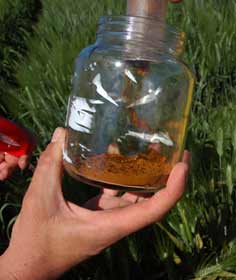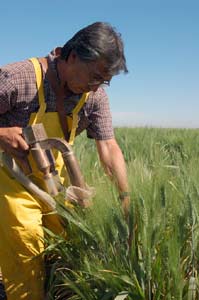CIMMYT E-News, vol 4 no. 3, March 2007
 Solving a major disease problem in durum wheat was not enough to satisfy farmers. They need and will get quality too.
Solving a major disease problem in durum wheat was not enough to satisfy farmers. They need and will get quality too.
Karim Ammar, a durum wheat breeder with CIMMYT, is proud of his new wheat lines growing green and disease-free this season in the Yaqui valley of northern Mexico. Even with the efficiency of a shuttle system between the Yaqui valley and the highland research station at Toluca, Mexico which allows wheat breeders to plant and select wheat twice a year, it still takes six years to get to where Karim is now.
“Between preliminary yield trials and elite yield trials we’ve got about 2500 lines and they are all resistant to leaf rust,” he says.
This is good news for the durum wheat farmers of the world. Durum wheat is the kind used for pasta, couscous and semolina. Today, 85% of spring durum wheat grown in developing countries traces its origins to the durum wheat program at CIMMYT in Mexico. The Center regularly sends out seed samples to national breeding programs around the developing world, and the most suitable in each region are used to breed local varieties. When mutations in the leaf rust fungus allowed it to bypass the resistance mechanisms in durum wheats, the breeding team at CIMMYT was faced with a serious problem.
“We had to rebuild the program, because you can no longer use something that becomes susceptible to a disease. That’s no service to the national programs or farmers in developing countries,” says Ammar, who comes from Tunisia. He is acutely aware that the work he is doing will have a major impact in developing countries where durum wheat is grown.
It might have been easy to look this as a single problem—producing disease-resistant plants or plants that can produce more grain—but the team realized the challenge was much more complicated. Farmers in developing countries need more than grain if their livelihoods are to improve. They need grain that is high in quality and for which there is a market.

Breeding itself is a process of combination and then elimination—selecting potentially good parent seeds with desirable characteristics and crossing them, then eliminating the offspring plants that don’t measure up. The process is cyclical and repeated until the breeder is satisfied that all required characteristics have been incorporated into the new wheat plants.
Leaf rust reduces yields enough to make growing susceptible varieties a losing proposition for farmers. Their needs were at the heart of the breeding strategy devised by the breeding team.
“So their priority becomes ours and once objectives are defined with our clients and their respective markets in mind, then I start thinking about the plants—how would a plant or a certain cross or combination of genes achieve that objective in the most efficient, fastest way possible,” Ammar says.
The breeders knew that disease resistance was vital but quality that was acceptable to farmers and their markets was equally essential. At the same time they thought they could enhance the performance of the wheats under drought stress and incorporate resistance to other diseases. In the beginning they had to sacrifice yield and other key characteristics to be sure they had resistance to the leaf rust, the biggest problem durum wheat growers were facing. But once that was done, the team focused on making the best possible wheats from all other perspectives.
“Now we’re back to the point where we can address yield, drought tolerance and quality very effectively because we know we have enough variability for rust resistance. It’s no longer the critical trait,” says Ammar.
The most critical trait now might well be the color or the quality of the gluten in durum wheat grains. Last year farmers in the Yaqui Valley of Mexico grew close to 150 000 ha of a durum wheat variety that yielded well and stood up to leaf rust. Unfortunately, because its grain did not have enough yellow pigment, desired by the export market, there was little market for the wheat except as pig feed. Many of the 2500 new lines that Ammar is testing outperform that variety in yield and in the most important quality traits
The best of the lines at the CIMMYT breeding station will be sent to national programs for evaluation. Mexico has already begun to evaluate in parallel so it will be ready as soon as possible to release new varieties based on the CIMMYT lines to the national production system .
For more information Karim Ammar, Wheat Breeder (k.ammar@cgiar.org)
 Capacity development
Capacity development